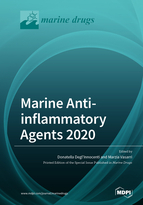Marine Anti-inflammatory Agents 2020
A special issue of Marine Drugs (ISSN 1660-3397).
Deadline for manuscript submissions: closed (31 December 2020) | Viewed by 18546
Special Issue Editors
Interests: bioactive natural products; inflammation; oxidative stress; polyphenols; cell migration; autophagy
Special Issues, Collections and Topics in MDPI journals
Interests: bioactive natural products; inflammation; oxidative stress; polyphenols; cell migration; autophagy
Special Issues, Collections and Topics in MDPI journals
Special Issue Information
Dear Colleagues,
Inflammation is a finely regulated defensive response against pathogens, toxic agents, cell injury, or tissue damage, aimed at evading or removing harmful stimuli and restoring tissue homeostasis. However, when the response goes unchecked, inflammation may lead to the pathogenesis of several diseases, including cancer, diabetes, atherosclerosis, arthritis and neurodegenerative diseases. The need to find new and powerful anti-inflammatory compounds has encouraged the scientific community to study the marine environment, which represents an excellent source of bioactive molecules. In this regard, the exploration of marine organisms with unique chemical diversity, including algae, plants, fungi, sponges, mollusks, and bacteria, represent a strategic goal for natural-based drug discovery against inflammation-related diseases.
As Guest Editor for this Special Issue of Marine Drugs, I invite you to report your research findings in the field of marine anti-inflammatory agents. Research that explores novel marine bioactive compounds and their molecular mechanisms is particularly encouraged. Moreover, findings that emphasize the potential biotechnological applications to reduce the environmental impact of chemical anti-inflammatory agents are also appreciated. Marine secondary metabolites could represent a sustainable innovation in the field of natural health products.
Prof. Dr. Donatella Degl'Innocenti
Dr. Marzia Vasarri
Guest Editors
Manuscript Submission Information
Manuscripts should be submitted online at www.mdpi.com by registering and logging in to this website. Once you are registered, click here to go to the submission form. Manuscripts can be submitted until the deadline. All submissions that pass pre-check are peer-reviewed. Accepted papers will be published continuously in the journal (as soon as accepted) and will be listed together on the special issue website. Research articles, review articles as well as short communications are invited. For planned papers, a title and short abstract (about 100 words) can be sent to the Editorial Office for announcement on this website.
Submitted manuscripts should not have been published previously, nor be under consideration for publication elsewhere (except conference proceedings papers). All manuscripts are thoroughly refereed through a single-blind peer-review process. A guide for authors and other relevant information for submission of manuscripts is available on the Instructions for Authors page. Marine Drugs is an international peer-reviewed open access monthly journal published by MDPI.
Please visit the Instructions for Authors page before submitting a manuscript. The Article Processing Charge (APC) for publication in this open access journal is 2900 CHF (Swiss Francs). Submitted papers should be well formatted and use good English. Authors may use MDPI's English editing service prior to publication or during author revisions.
Keywords
- marine bioactive compounds
- inflammation
- inflammation-related disease
- NF-kB
- pro-inflammatory cytokines
- oxidative stress
- ROS
- polyphenols
Related Special Issues
- Marine Anti-inflammatory and Antioxidant Agents 2021 in Marine Drugs (11 articles)
- Marine Anti-inflammatory and Antioxidant Agents 2.0 in Marine Drugs (11 articles)
- Marine Anti-inflammatory and Antioxidant Agents 3.0 in Marine Drugs (10 articles)








